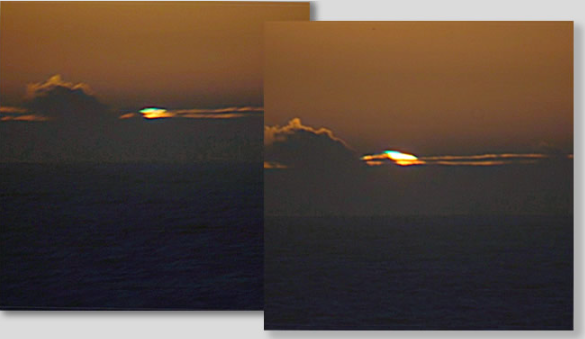Cloud top green flash
Cloud Top Green Flash: A Rare Atmospheric Phenomenon
Have you ever witnessed a green flash as the sun sets? It's a mesmerizing sight that occurs when atmospheric conditions are just right. While green flashes are commonly associated with the horizon, did you know that they can also occur at cloud tops? Yes, even when the horizon is cloudy, there is a chance of witnessing a rare cloud-top green flash. In this article, we will explore this intriguing phenomenon and delve into the possible explanations behind it.
When the sun sinks behind a distant cloud bank, an enigmatic cloud-top flash can sometimes be observed. These flashes exhibit a deep emerald green color, occasionally accompanied by hints of blue. Although not fully understood, they are believed to be a type of mock-mirage flash resulting from an inversion layer overlaying the clouds. However, further observations and detailed weather data are required to gain a comprehensive understanding of this captivating occurrence.
The Nature of Cloud-Top Green Flashes
Cloud-top green flashes share similarities with their more common counterparts seen at the horizon. Both phenomena are caused by the refraction of sunlight through the Earth's atmosphere. As sunlight passes through the atmosphere, it undergoes dispersion, causing different colors to separate. The atmosphere acts as a prism, bending the light and allowing us to witness these vibrant displays.
However, while green flashes at the horizon are typically associated with atmospheric layers near the Earth's surface, cloud-top green flashes occur higher up in the atmosphere. They are thought to be influenced by inversion layers, which are regions where temperature increases with height rather than decreases as it normally does. These inversion layers can occur above clouds and create unique conditions for the formation of cloud-top green flashes.
The Role of Inversion Layers
Inversion layers play a crucial role in the formation of cloud-top green flashes. An inversion layer acts as a boundary between two air masses with different temperatures. When the sun sets behind a distant cloud bank, the light passes through the inversion layer and interacts with the clouds above. This interaction causes the light to refract in a peculiar manner, resulting in the striking green color observed during these flashes.
Unraveling the Mystery
While cloud-top green flashes have been observed and documented, they remain somewhat mysterious. Scientists and atmospheric optics enthusiasts are still working to unravel the intricacies of this phenomenon. To gain a deeper understanding, more observations and associated weather data are needed. By studying the atmospheric conditions during these events, researchers can piece together the puzzle and shed light on the mechanisms behind cloud-top green flashes.
Observations and Weather Data
To enhance our knowledge of cloud-top green flashes, it is essential to gather as much observational data as possible. Scientists and enthusiasts can contribute to this effort by documenting their sightings and noting relevant weather conditions. By collecting a diverse range of observations, researchers can identify patterns and correlations that may offer insights into the occurrence and characteristics of cloud-top green flashes.
The Fascination of Atmospheric Optics
Atmospheric optics is a field that continuously surprises us with its stunning displays and enigmatic phenomena. From iridescent clouds to halos, each occurrence offers a glimpse into the intricate workings of our atmosphere. Cloud-top green flashes add yet another layer of fascination to this field, showcasing the complexity and beauty of atmospheric interactions.
Conclusion
Cloud-top green flashes are a captivating and rare atmospheric phenomenon. While green flashes are commonly associated with the horizon, these flashes occur at cloud tops when specific conditions align. Although not fully understood, inversion layers overlaying clouds are believed to play a significant role in their formation. By gathering more observations and weather data, we can further our understanding of this mesmerizing occurrence. Atmospheric optics continues to amaze us with its mysteries, reminding us of the awe-inspiring wonders that surround us in the sky.

Cloud-top flashes imaged by Lyudmila Zinkova at San Francisco, October '05. That on the left is a deep emerald green, the one on the right has some blue. ©2005 Lyudmila Zinkova, shown with permission.
Do not assume when the horizon is cloudy that a green flash will not be seen. Sometimes a rare cloud-top flash can occur as the sun sinks behind a distant cloud bank. They are not fully understood but might be a type of mock-mirage flash produced by an inversion layer overlaying the clouds. We need more observations and associated weather data to understand them better.
Note: this article has been automatically converted from the old site and may not appear as intended. You can find the original article here.
Reference Atmospheric Optics
If you use any of the definitions, information, or data presented on Atmospheric Optics, please copy the link or reference below to properly credit us as the reference source. Thank you!
-
<a href="https://atoptics.co.uk/blog/cloud-top-green-flash/">Cloud top green flash</a>
-
"Cloud top green flash". Atmospheric Optics. Accessed on November 26, 2024. https://atoptics.co.uk/blog/cloud-top-green-flash/.
-
"Cloud top green flash". Atmospheric Optics, https://atoptics.co.uk/blog/cloud-top-green-flash/. Accessed 26 November, 2024
-
Cloud top green flash. Atmospheric Optics. Retrieved from https://atoptics.co.uk/blog/cloud-top-green-flash/.